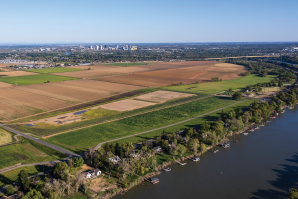This is a sidebar to September’s feature story on housing.
The City of Sacramento has earned recognition for doing more than most communities to reduce California’s housing shortage.
In the last four years, Sacramento has approved more than 11,000 housing units, the third-highest total in the state, according to figures from the California Department of Housing and Community Development. The city’s total of approved housing trails only Los Angeles and San Diego, both of which are much larger cities.
In addition, Sacramento two years ago became the first jurisdiction in the state to earn a “prohousing” designation from the Department of Housing and Community Development. The Prohousing Designation Program provides “support, incentives, and accountability measures to help meet California’s housing goals,” the department website says. Since then, Placer County, Roseville and Citrus Heights, along with other jurisdictions outside the Capital Region, have received the designation.
Sacramento Planning Director Greg Sandlund attributes the city’s success to a revision of its general plan — the guiding document for development — in 2009. The updated plan emphasizes the development of apartments, condos and other types of multifamily housing in existing communities, a process known as infill.
The city’s general plan is heavily influenced by a regional land use plan called the Blueprint, created by the Sacramento Area Council of Governments, Sandlund says. The Blueprint emphasizes infill development as well.
The results can be seen in Midtown Sacramento and other central city communities, where trendy and upscale condos are mixed in with affordable apartments. More than 70 percent of the approved housing in Sacramento in recent years has been multifamily.
For example, Anthem is building 225 rental apartments at 905 S Street. Anthem also built Maker in Midtown, a 137-apartment complex on R Street.
The emphasis has also been on affordable: Most of the housing has been considered affordable for households of moderate, low or very low incomes ($109,000 a year or less for a household of two).
Federal, state and local subsidies help pay for the housing.
It took a while for the city’s plans to work, in large part because the Great Recession and associated foreclosure issues had a strong impact on Sacramento’s housing market, Sandlund says. The city further kickstarted construction by making it easier for builders to get through the city’s approval process.
“We’re taking the politics out of the housing policy,” he says,
adding that local opposition to development — also known as
NIMBYism, for “not in my backyard” — seems increasingly rare.
Sacramento’s approach can work in other parts of the region,
experts say.
“Multifamily construction is booming,” Alex Steinberger of Cascadia Partners told the Sacramento Area Council of Governments earlier this year, as the agency updated the Blueprint.
Several trends are driving an increase in multifamily housing, he
says. Baby Boomers are moving into smaller homes and apartments,
while Generation Z is just entering the housing market. Also,
people are interested in walkable communities with services and
shops nearby.
But single-family homes remain popular in some communities. In
Roseville, for instance, 5,600 single-family homes have been
approved for construction in the last four years, making up most
of their new housing. Roseville approved the ninth-most housing
in the state in that period. All the jurisdictions approving more
housing than Roseville have much larger populations.
Just north of Roseville, Taylor Builders last year started
construction on Placer One, a master-planned community previously
called Placer Ranch. More than 5,000 residential units are
expected, along with college extension programs by Sacramento
State and Sierra College.
Several developers are building at Folsom Ranch, a master-planned
community south of Highway 50. More than 3,000 homes have been
built in the community that is expected to have as many as
11,000.
While unincorporated Sacramento County has plans to add up to 100,000 housing units in coming decades, it has seen relatively little housing activity in the last four years — less than 3,000 units permitted or about a fourth as much as the City of Sacramento. Most of it has been single-family housing.
Tim Murphy, president and chief executive officer at North State Building Industry Association, says developers are committed to providing housing to all parts of the market, including people who want downtown apartments and suburban homes.
Recommended For You

Fighting for Land
We need more housing, but we also want to protect wildland
The region has been suffering through a housing shortage for several years. But environmentalists worry about the impacts of greenfield development: It increases greenhouse gas emissions as people commute longer distances and causes the loss of habitat and open space, which gives the region its character and makes it a good place to live.

The Need for Nurses
The Capital Region has a nursing shortage. Here’s what health care systems, schools and others are doing about it
National Center for Health Workforce Analysis figures from November 2022 show there could be a shortage of over 78,000 full-time registered nurses in the U.S. by next year, and that the shortage could last several years. CalMatters reported in July 2023 that California was short around 36,000 licensed nurses, citing figures from UC San Francisco, which studies the nursing workforce.

Are We Ready for the Electric Revolution?
The Capital Region is leading the charge to make California EV compliant in the next decade
These days, there is a sense of possibility in Sacramento when it comes to zero emissions technology. Sacramento may not have the population numbers of New York or Los Angeles, but when it comes to EV infrastructure the California capital plays second fiddle to no city in America.

Ready, Set, Action!
Filmmakers big and small are finding the region a congenial place to make movies
For several days this winter, Sacramentans got to play “Spot the Movie Star” while Leonardo DiCaprio and William Baldwin were both in town filming two different movies at locations all over the city. It begs the question: Could Sacramento become Hollywood North? The city and nearby Placer and El Dorado counties have a growing film industry that brings millions of dollars and thousands of jobs into the region.

We Oughta Be in Pictures!!
FROM THE PUBLISHER: Our region has long been one of Hollywood’s well-known secrets. Because of the area’s natural beauty and close to year-round clement weather (the two compelling reasons that made filmmakers leave New York in the early 1920s for a stronghold in Southern California), movies, TV shows and commercials have been shot here for years. What if we had our own film studio?

From Farm to Glass
They’re just miles apart, but Capital Region wine regions are distinctively different based on their climate, terrain and soil
Each of our four wine regions has its own unique terroir, a French term describing the soil, climate and sunshine that give wines their distinct character. These winemakers want consumers to consider their wines farm-to-fork — that is, farm-to-glass.

What Does a California Lobbyist Do?
Often referred to as the third house of the state legislature, lobbyists spend long days advocating for their clients
California is one of only 10 states that has a full-time professional legislature, and last year, companies and industries spent a record high $480 million on lobbying efforts in the state.




